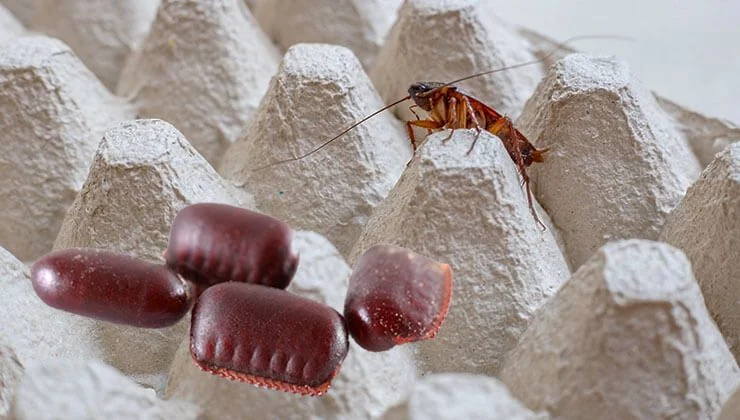Cockroach eggs are enclosed in a protective casing called an ootheca, which varies in size, color, and shape depending on the species. The German cockroach, one of the most common pests in Canadian homes, produces a light brown ootheca that is about 6-9 mm long and contains 30-40 eggs. On the other hand, American cockroaches have darker, larger egg cases that hold around 14-16 eggs.
Identifying a cockroach egg sack early is crucial to preventing an infestation. These casings are often found in hidden, warm areas such as kitchen cabinets, behind appliances, inside cracks, and near plumbing fixtures. If you spot a roach egg capsule, it’s a strong indication of an active infestation that requires immediate attention.
Where Do Roaches Lay Eggs?
Cockroaches prefer to deposit their oothecae in secluded, humid locations where the eggs can develop safely. In Canadian homes, common hiding spots include:
- Under sinks and behind dishwashers – The moisture and warmth attract female roaches looking for a nesting site.
- Inside pantry shelves and food storage areas – Crumbs and spills provide nourishment for newly hatched cockroach larvae.
- Behind baseboards and wall cracks – These tight spaces offer protection from predators and human interference.
- Near garbage bins and recycling areas – Rotting food waste is a prime breeding ground for roach eggs.
Since cockroach egg cases are often hidden, a thorough inspection by a professional pest control service like IPM Pest Solutions is the best way to detect and eliminate them before they hatch.
The Life Cycle of German Cockroaches
Understanding the German cockroach life cycle is essential for effective pest control. These roaches reproduce rapidly, making them a persistent problem in Toronto, Vancouver, and Montreal homes.
- Egg Stage (Ootheca) – A female roach carries the ootheca for about 24-48 hours before depositing it in a secure location. The German roach eggs hatch in approximately 28-30 days.
- Nymph Stage – After hatching, the cockroach baby (nymph) undergoes several molting stages before reaching adulthood.
- Adult Stage – Within 50-60 days, the nymph matures into an adult capable of reproducing. A single female cockroach can produce 4-8 oothecae in her lifetime, leading to exponential infestation growth.
Because German cockroaches multiply quickly, early intervention is critical. If you notice roach egg sacks or live insects, contact a pest control expert immediately.
How Many Eggs Does a Cockroach Lay?
The reproductive capacity of cockroaches varies by species:
- German cockroaches – Each ootheca contains 30-40 eggs, and a single female can produce hundreds of offspring in her lifetime.
- American cockroaches – Their egg cases hold 14-16 eggs, but they have a longer development period.
- Oriental cockroaches – These roaches lay 16-18 eggs per ootheca and prefer damp, cool environments like basements.
Given how fast cockroaches multiply, even a few roach eggs can lead to a full-blown infestation if left unchecked.
How Long Does It Take for Cockroach Eggs to Hatch?
The incubation period for cockroach eggs depends on temperature and humidity. In warm Canadian kitchens, German roach eggs may hatch in 3-4 weeks, while American cockroach eggs can take 6-8 weeks. Once hatched, the cockroach larvae (nymphs) emerge and begin searching for food.
If you find an empty cockroach egg case, it means the nymphs have already dispersed, increasing the risk of infestation. Regular inspections and sanitation are key to preventing roach eggs from developing into adults.
Signs of a Cockroach Infestation
Besides spotting roach oothecae, other signs of an infestation include:
- Live or dead cockroaches – Especially in kitchens, bathrooms, and basements.
- Musty odors – A strong, unpleasant smell often indicates a large population.
- Droppings – Tiny black specks resembling coffee grounds near food sources.
- Shed skins – As nymphs grow, they molt, leaving behind exoskeletons.
If you notice any of these signs, it’s time to take action before the problem worsens.
How to Prevent Cockroach Eggs in Your Home
Preventing cockroach egg sacks starts with good sanitation and exclusion practices:
- Seal Entry Points – Check for gaps around pipes, windows, and doors. Cockroaches can squeeze through tiny openings.
- Store Food Properly – Keep pantry items in airtight containers and avoid leaving pet food out overnight.
- Eliminate Moisture – Fix leaky faucets and use dehumidifiers in damp areas like basements.
- Regular Cleaning – Wipe down counters, sweep floors, and take out the trash frequently to remove food residues.
- Professional Pest Control – DIY methods often miss hidden roach eggs. A licensed exterminator can provide targeted treatments.
Why Choose IPM Pest Solutions for Cockroach Control?
At IPM Pest Solutions, we specialize in cockroach detection and elimination using eco-friendly, effective methods. Ensuring homes and businesses remain pest-free.
We focus on:
- Thorough inspections to locate roach egg cases and nesting sites.
- Customized treatments that target both adults and cockroach larvae.
- Preventative strategies to stop future infestations.
Don’t let cockroach eggs turn into a major problem. Contact IPM Pest Solutions today for expert roach control in Canada!





